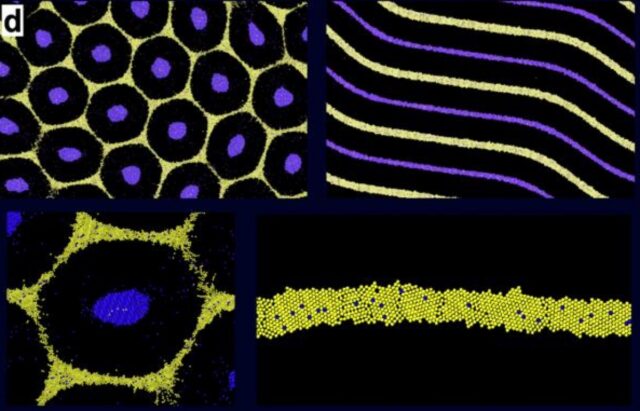Akita Prefecture has Japan's most aged population, lowest birthrate and fastest declining population. Rigid gender roles are prompting young women to leave rural areas like this for opportunities elsewhere.



While on furlough, Isaac Stein is fulfilling a childhood dream and passion project as a hot dog vendor.
(Image credit: Ava Pukatch)
A zebra’s distinctive black-and-white stripes, or a leopard’s spots, are both examples of “Turing patterns,” after mathematician and computer scientist Alan Turing, who proposed an intriguing hypothetical mechanism for how such complex, irregular patterns might emerge in nature. But Turing’s original proposal proved too simplified to fully re-create those natural patterns. Scientists at the University of Colorado at Boulder (UCB) have devised a new modeling approach that achieves much more accurate final patterns by introducing deliberate imperfections, according to a new paper published in the journal Matter.
Turing focused on chemicals known as morphogens in his seminal 1952 paper. He devised a mechanism involving the interaction between an activator chemical that expresses a unique characteristic (like a tiger’s stripe) and an inhibitor chemical that periodically kicks in to shut down the activator’s expression. Both activator and inhibitor diffuse throughout a system, much like gas atoms will do in an enclosed box. It’s a bit like injecting a drop of black ink into a beaker of water. Normally, this would stabilize a system, and the water would gradually turn a uniform gray. But if the inhibitor diffuses at a faster rate than the activator, the process is destabilized. That mechanism will produce spots or stripes.
Scientists have tried to apply this basic concept to many different kinds of systems. For instance, neurons in the brain could serve as activators and inhibitors, depending on whether they amplify or dampen the firing of other nearby neurons—possibly the reason why we see certain patterns when we hallucinate. There is evidence for Turing mechanisms at work in zebra-fish stripes, the spacing between hair follicles in mice, feather buds on a bird’s skin, the ridges on a mouse’s palate, and the digits on a mouse’s paw.
Certain species of Mediterranean ants will pile the dead bodies of ants into structures that seem to exhibit Turing patterns. There is evidence of Turing patterns in the movement of Azteca ant colonies on coffee farms in Mexico. And in 2021, a team of Spanish scientists managed to tweak E. coli in the laboratory so that the colonies exhibited branching Turing patterns.
In essence, it’s a type of symmetry breaking. Any two processes that act as activator and inhibitor will produce periodic patterns and can be modeled using Turing’s diffusion function. The challenge is moving from Turing’s admittedly simplified model to pinpointing the precise mechanisms serving in the activator and inhibitor roles.
This is especially challenging in biology. Per the authors of this latest paper, the classical approach to a Turing mechanism balances reaction and diffusion using a single length scale, but biological patterns often incorporate multiscale structures, grain-like textures, or certain inherent imperfections. And the resulting patterns are often much blurrier than those found in nature.
Can you say “diffusiopherosis”?
 Simulated hexagon and stripe patterns obtained by diffusiophoretic assembly of two types of cells on top of the chemical patterns.
Credit:
Siamak Mirfendereski and Ankur Gupta/CU Boulder
Simulated hexagon and stripe patterns obtained by diffusiophoretic assembly of two types of cells on top of the chemical patterns.
Credit:
Siamak Mirfendereski and Ankur Gupta/CU Boulder
In 2023, UCB biochemical engineers Ankur Gupta and Benjamin Alessio developed a new model that added diffusiopherosis into the mix. It’s a process by which colloids are transported via differences in solute concentration gradients—the same process by which soap diffuses out of laundry in water, dragging particles of dirt out of the fabric. Gupta and Alessio successfully used their new model to simulate the distinctive hexagon pattern (alternating purple and black) on the ornate boxfish, native to Australia, achieving much sharper outlines than the model originally proposed by Turing.
The problem was that the simulations produced patterns that were too perfect: hexagons that were all the same size and shape and an identical distance apart. Animal patterns in nature, by contrast, are never perfectly uniform. So Gupta and his UCB co-author on this latest paper, Siamak Mirfendereski, figured out how to tweak the model to get the pattern outputs they desired. All they had to do was define specific sizes for individual cells. For instance, larger cells create thicker outlines, and when they cluster, they produce broader patterns. And sometimes the cells jam up and break up a stripe. Their revised simulations produced patterns and textures very similar to those found in nature.
“Imperfections are everywhere in nature,” said Gupta. “We proposed a simple idea that can explain how cells assemble to create these variations. We are drawing inspiration from the imperfect beauty of [a] natural system and hope to harness these imperfections for new kinds of functionality in the future.” Possible future applications include “smart” camouflage fabrics that can change color to better blend with the surrounding environment, or more effective targeted drug delivery systems.
Matter, 2025. DOI: 10.1016/j.matt.2025.102513 (About DOIs).
